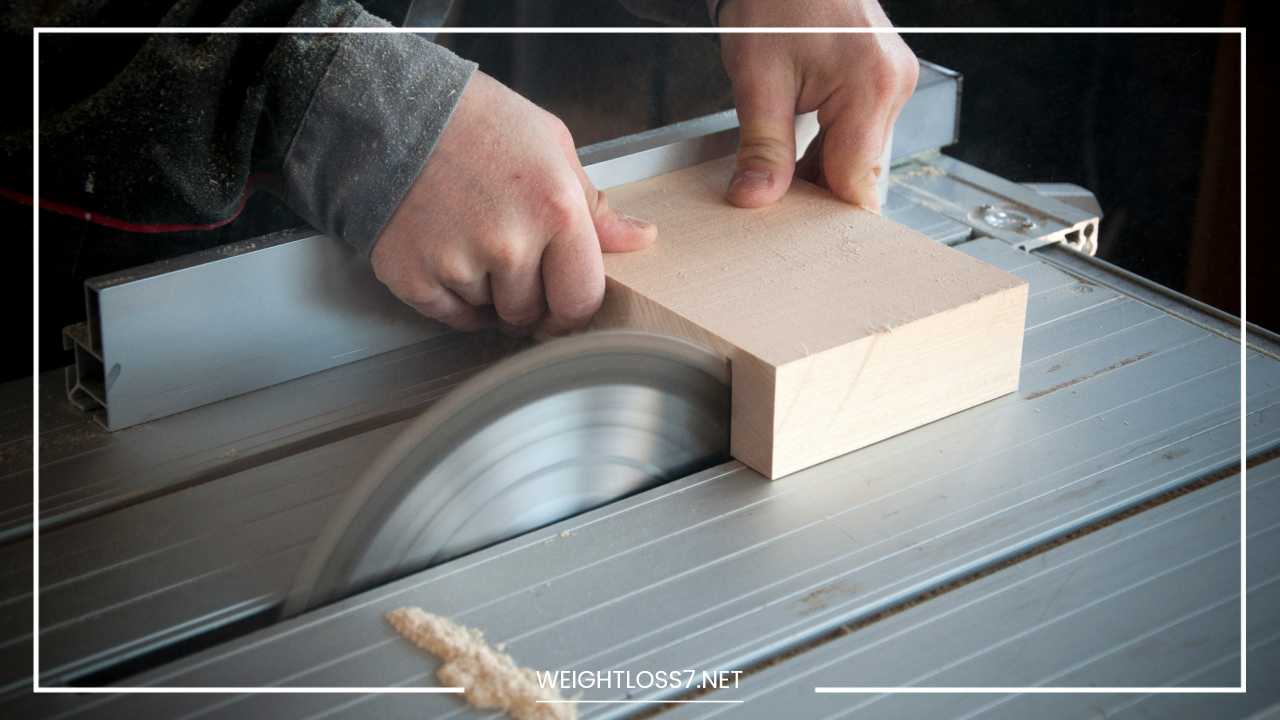Staying Safe While Working With Wood

Woodworking
Staying Safe While Working With Wood: A Guide for Every Woodworker
Woodworking is a therapeutic and fulfilling pursuit. The sense of accomplishment you get from transforming raw lumber into a beautiful and functional piece is unparalleled. However, like any activity that involves tools and machinery, safety should be your top priority.
This comprehensive guide delves into essential safety practices for woodworkers of all experience levels. By following these tips, you can create a safe and healthy workspace, minimize the risk of accidents, and ensure a long and enjoyable woodworking journey.
Gearing Up for Safety: Essential Personal Protective Equipment (PPE)
Personal Protective Equipment (PPE) serves as your primary defense against the hazards inherent in woodworking. Consider these crucial pieces of PPE as non-negotiable:
-
Safety Glasses or Goggles: Wood dust, chips, and debris can propel themselves at alarming speeds. Safety glasses with side shields or well-fitting goggles are vital to safeguard your eyes. Invest in high-quality eyewear that meets the American National Standards Institute (ANSI) Z87.1 standard for impact resistance.
-
Ear Protection: Prolonged exposure to the loud noise generated by power tools can lead to permanent hearing damage. Utilize earplugs or earmuffs that provide adequate Noise Reduction Rating (NRR) for the specific tool you’re operating. A general rule of thumb is to use ear protection if you struggle to hold a conversation at arm’s length due to the noise level.
-
Dust Mask or Respirator: Wood dust can irritate your lungs and may contain harmful substances depending on the type of wood. When sanding, sawing, or working with treated lumber, don a dust mask. For tasks that generate significant dust or fumes, a respirator with a High-Efficiency Particulate Air (HEPA) filter is highly recommended.
-
Gloves: Gloves shield your hands from splinters, cuts, and exposure to chemicals like glues and stains. Choose gloves that offer good dexterity for optimal tool control. However, avoid wearing gloves too close to moving blades where they can snag and cause serious injuries.
-
Steel-toed Boots: Falling wood and dropped tools can inflict severe foot injuries. Steel-toed boots provide essential protection. Opt for well-fitting boots with good traction to prevent slips and falls on potentially uneven workshop floors. Consider features like electrical hazard protection if working with power tools near electrical outlets.
Dress for Success: Safe Clothing Choices
The urge to throw on old clothes for a quick woodworking session might be strong, but resist it. Loose-fitting clothing, dangling jewelry, and scarves pose significant entanglement hazards around machinery.
Here’s a breakdown of safe clothing choices for the workshop:
- Fitted Clothing: Opt for well-fitting shirts and pants that won’t get caught in tools or snag on protruding screws or nails.
- Secure Long Hair: Tie back long hair to prevent it from getting tangled in machinery.
- No Jewelry: Remove all rings, bracelets, and necklaces before starting work. These can catch on tools and cause injuries or even ripped-off fingers.
Creating a Hazard-Free Zone: Workshop Safety Essentials
The layout and organization of your workshop significantly impact accident prevention. Here are some key points to consider for a safe workspace:
- Clear Work Area: Maintain a clean and clutter-free workspace. This allows for better movement and reduces the risk of tripping over tools or materials. Designate specific storage areas for tools and lumber to prevent clutter build-up.
- Proper Lighting: Ensure your workshop has ample lighting to see your work clearly and avoid mistakes that could lead to injuries. Strategically placed task lighting is particularly beneficial for detail-oriented work like sanding and intricate cuts.
- Ventilation: Woodworking dust can be harmful if inhaled. Proper ventilation is essential to remove dust and fumes from the workshop. Open windows and doors whenever possible to promote natural ventilation. Additionally, consider installing a dust collection system to capture dust particles at their source, especially when working with power tools.
- Sharp Tools: Dull tools require more force to operate, increasing the risk of accidents and user fatigue. Make sure your tools are always sharp and well-maintained. Regularly sharpen chisels, plane blades, and other cutting tools according to the manufacturer’s recommendations. Invest in a quality sharpening stone or honing guide for optimal results.
- Power Tool Safety: Always unplug power tools before changing blades, bits, or performing maintenance. Double-check that the tool is switched off before connecting it to the power source. Develop the habit of unplugging tools whenever they are not in use to prevent accidental activation.
Mastering Power Tools: Safe Techniques for Optimal Results
Power tools are incredibly valuable assets in the workshop, but they demand respect and proper handling. Here are essential power tool safety practices to remember:
-
Read the Manual: Always thoroughly consult the user manual for each power tool before operating it. The manual provides invaluable information about the tool’s capabilities, limitations, and proper operating procedures. Familiarize yourself with safety features, blade changes, and troubleshooting tips specific to the tool.
-
Use the Right Tool for the Job: Don’t attempt to force a tool to perform a task it wasn’t designed for. Using the wrong tool can lead to breakage, malfunction, and potential injuries. For example, a circular saw is not a substitute for a miter saw for making precise angled cuts.
-
Secure Your Workpiece: Always clamp or secure your wood securely to your workbench before using power tools. A loose workpiece can cause kickback, a dangerous situation where the wood suddenly lurches back towards the operator. Use properly sized clamps and ensure they have a good grip on the wood.
-
Maintain Control: Keep your hands well away from the cutting path of blades and bits. Utilize push sticks or jigs to feed material through power tools safely. Push sticks are long, narrow pieces of wood used to guide lumber through saws and planers without putting your fingers at risk. Jigs hold the workpiece in place and provide a controlled cutting path for tools like routers.
-
Never Reach Over Running Blades: Patience is key. Always wait for the blade to come to a complete stop before reaching over or across it to make adjustments or remove scraps. A spinning blade can cause serious injuries even with momentary contact.
-
Cord Management: Keep power tool cords organized and away from the cutting path to prevent accidental cuts or tripping hazards. Utilize extension cords with adequate wire gauge to handle the current draw of the tool you’re using. Coiling excess cord can also help prevent tripping.
Material Handling: Working with Wood Safely
Wood itself can present hazards if not handled properly. Here’s how to ensure safe wood handling practices:
- Inspect Lumber: Before working with wood, check for loose knots, cracks, and warping. Damaged wood can break unexpectedly and cause injuries. Discard or reinforce lumber with severe cracks or loose knots that compromise its structural integrity.
- Sharp Edges: Be aware of sharp edges on lumber that can cause cuts. Use gloves and handle wood carefully, especially rough-cut lumber or plywood with exposed plies.
- Heavy Lifting: Don’t attempt to lift heavy pieces of wood by yourself. Enlist help or use a mechanical lifting device like a hoist or lumber cart to avoid back strain or injuries. Improper lifting techniques can lead to muscle strain, hernias, and other serious injuries.
Beyond the Basics: Additional Safety Tips for Woodworkers
- Know Your Limits: Be honest with yourself about your skill level and the capabilities of your tools. Don’t attempt complex projects beyond your experience level. Take woodworking classes or seek guidance from experienced woodworkers to learn new techniques safely.
- Focus and Avoid Distractions: Woodworking requires focus and concentration to operate tools safely. Avoid distractions like loud music or multitasking while using machinery.
- Take Breaks: Fatigue can lead to carelessness. Take regular breaks to stay alert and avoid mistakes that could result in injuries.
- Maintain a First-Aid Kit: Be prepared for minor accidents by having a well-stocked first-aid kit readily available in your workshop. The kit should contain essential supplies like bandages, antiseptic wipes, and pain relievers.
- Keep a Fire Extinguisher Handy: Woodworking involves flammable materials like sawdust and solvents. Having a properly charged fire extinguisher close by can help you extinguish small fires before they escalate.
Woodworking: A Journey of Safety and Creativity
By prioritizing safety and following these essential practices, you can create a positive and productive woodworking environment.
Remember, safety is not an afterthought; it’s an integral part of the woodworking process. With a commitment to safety, you can ensure a long and enjoyable woodworking journey filled with the satisfaction of creating beautiful and functional pieces.
Advanced Techniques and Safe Practices for Experienced Woodworkers
As your woodworking skills progress, you’ll likely encounter new tools and techniques. Here are some safety considerations for experienced woodworkers:
-
Working with Power Saws:
- Miter Saws: When using a miter saw for angled cuts, always double-check your measurements and ensure the material is secure against the fence. Utilize a stop block to control the length of the cut and prevent the wood from tipping during sawing.
- Table Saws: Always use a riving knife or splitter blade with your table saw to prevent kickback. These safety features help keep the cut open behind the blade, reducing the risk of the wood pinching and launching back towards you.
- Circular Saws: When using a circular saw for freehand cuts, employ a circular saw guide or track for straighter cuts and better control. Maintain a firm grip on the saw and keep your body positioned to the side of the blade to avoid the line of cut in case of kickback.
-
Woodworking Joiners and Routers:
- Jointers: Jointing involves running lumber over rotating blades to achieve a flat and true surface. When using a jointer, ensure the infeed and outfeed tables are properly adjusted for a slight downward slope to prevent snipe (uneven burning or tear-out at the end of the workpiece).
- Routers: Routers are versatile tools for shaping wood, but their bits spin at high speeds. Always use the appropriate router bit for the desired cut and ensure it’s securely fastened in the collet. Utilize featherboards or a push block to control the wood and prevent it from grabbing the bit.
-
Dust Control and Air Filtration: As you delve into more complex projects that generate significant dust, consider investing in a dust collection system with a dedicated dust collector or by connecting your shop vacuum to your power tools. This will help capture dust particles at the source, reducing airborne dust and improving air quality in your workshop.
-
Working with Finishing Materials: Many stains, paints, and lacquers used in woodworking contain volatile organic compounds (VOCs) that can be harmful if inhaled. Ensure proper ventilation when working with finishing materials. Open windows and doors whenever possible, and consider using a respirator with organic vapor cartridges for additional protection.
-
Machine Maintenance: Regularly inspect and maintain your woodworking machinery. This includes checking for loose parts, dull blades, and malfunctioning safety features. Replace dull blades promptly and address any maintenance concerns before using the tool again.
Safety Beyond the Workshop:
Woodworking safety extends beyond the confines of your workshop. Here are some additional tips to consider:
-
Hearing Protection Beyond the Workshop: Exposure to loud noises, even for short durations outside the workshop, can damage your hearing. If you frequently attend woodworking shows, demonstrations, or use power tools in non-workshop settings, wear earplugs or earmuffs for continued hearing protection.
-
Sharpening Safety: While sharpening tools yourself can save money, it’s important to prioritize safety. Utilize proper sharpening techniques and wear appropriate safety gear like gloves and eye protection to prevent injuries from sharpening stones or flying metal fragments.
-
Safe Disposal of Wood Waste: Woodworking generates scrap wood and sawdust. Properly dispose of wood waste to avoid creating fire hazards or environmental concerns. Many communities have designated collection points for scrap wood, and sawdust can often be composted (depending on the type of wood and any finishes used).
By following these safety practices and remaining vigilant, you can ensure a long and rewarding woodworking experience.
Remember, safety is not a chore; it’s an investment in your health and well-being that allows you to continue enjoying this fulfilling craft for years to come.
Happy and safe woodworking!

















